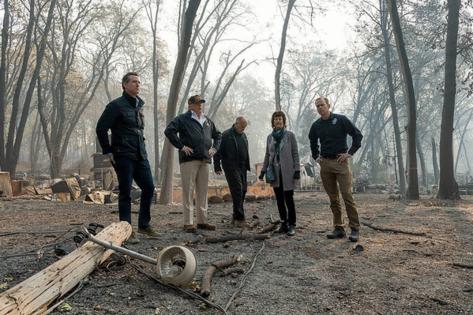California braces for climate conflict but aligns with Trump on forest management
Published in News & Features
SACRAMENTO — California leaders are bracing for a clash with Donald Trump on most environmental issues when he returns to the White House, but they’re surprisingly aligned with him on forest management.
Since his first term as president, Trump has blamed the state for its devastating wildfires, telling leaders to thin out its forest and clear out the forest floors to lower risk. Research shows he wasn’t entirely off base.
Decades of fire suppression have California left forests overgrown, making them more vulnerable to severe wildfires intensified by climate change.
In 2020, the state ramped up efforts to thin forests, setting a goal of treating one million acres of forest land a year. Now it may even support a controversial timber-based energy industry that’s backed by Project 2025, the conservative federal policy blueprint.
About 15 million of California’s 33 million acres of forest land need to be thinned or burned to become healthy and more resilient to wildfires, according to the U.S. Forest Service.
The two main ways to achieve that goal, scientists say, is setting controlled fires to mimic natural fire cycles and mechanical thinning: logging or cutting smaller trees, shrubs and vegetation.
Between 2021 and 2023, state agencies and private companies thinned about 267,000 forest acres in California and conducted prescribed burns on about 148,000 acres, according to state data.
As goes Finland, so goes California?
After the devastating Camp Fire in 2018, Trump said in a press conference with Gov. Gavin Newsom and former Gov. Jerry Brown that the state needed to clean the forest floors.
He said at the time that Finland spends a “lot of time raking, cleaning and doing things, and they don’t have any problem” with wildfires, prompting looks of confusion.
It’s a message he repeated on the 2020 campaign trail and suggesting this year that California should wet forest floors to reduce fire risk. He also threatened to withhold federal disaster aid unless the state complied.
Prescribed fire and mechanical thinning are now accepted state policy.
But he also appeared to refer to a more controversial industry called forest biomass, where organic forest materials — small trees, dead trees and underbrush — are turned into wood pellets and burned as fuel to replace coal.
It’s common in Europe, and in some Southeastern states, where companies have used millions in government subsidies to create electricity with biomass, as a lower-carbon replacement for coal.
Project 2025, the policy blueprint developed by the Heritage Foundation, also promotes the industry. It said the Forest Service should “reduce dependency on fires” by shifting focus to “the precipitous annual amassing of biomass.”
Instead of relying on “unplanned” fires, according to the document, the government could minimize wildfire consequences through tree thinning, live fuel removal, and increased timber sales.
Wood pellet biomass is often marketed as renewable. But environmentalists criticize it for releasing significant carbon emissions like fossil fuels and say it incentivizes removal of mature trees from forests.
“When Trump said that years ago, I thought, ‘This could open the door for California’s wood pellet industry,’” said Rita Vaughan Frost, a forestry advocate for the Natural Resources Defense Council. “It seems my worst fears have come true.”
Shipping California trees to burn elsewhere
As Vaughan Frost feared, California could soon see the emergence of a forest biomass wood pellet industry.
Golden State Natural Resources, a non-profit organization established by a coalition of rural California counties, is spearheading a $540 million project aimed to help meet the state’s forest thinning targets.
The project, overseen by the Rural County Representatives of California (RCRC) would turn overgrown biomass into a commercial product by removing small excess trees from forests and turning them into wood pellets to be exported as fuel.
The plan also includes construction of two new wood pellet processing facilities in Lassen County and Tuolumne County. The pellets would be trucked to another storage site at the Port of Stockton where the pellets would be shipped out.
The project’s developers said it has support in California mountain communities that have lost timber industry jobs since the 1990s. They said the operation would create about 120 jobs.
“Our main point is the significant benefits that come from the projects, and ultimately trying to reduce catastrophic wildfire to better protect communities and property, and forest health,” said RCRC spokesperson Carolyn Jhajj.
The project requires a lengthy permitting process and is undergoing an environmental review. It also needs additional financing — roughly $12 million has been secured, in part from federal subsidies.
The biomass campaign has not received support from Gov. Gavin Newsom or other California climate leaders, but it hasn’t received pushback either.
California biomass is already taking heat from environmental groups, who say it will add new air pollution from trucks in burdened communities of Stockton and greenhouse gas emissions to the atmosphere.
“The project is not going to mitigate wildfires or make forests more resilient,” said Vaughan Frost with the NRDC. “It’s going to increase carbon emissions and have all these environmental justice implications.”
The draft environmental review found it would result in forests retaining carbon but could conflict with state climate goals because the project’s emissions from transporting all the materials are “significant and unavoidable.”
“There are impacts from the project related to air quality and greenhouse gas emissions,” Jhajj said, adding the project would take steps to reduce pollution in Stockton. “To us that pales in comparison to catastrophic wildfire events.”
---------
Sacramento Bee reporter Phillip Reese contributed to this story.
____
©2024 The Sacramento Bee. Visit at sacbee.com. Distributed by Tribune Content Agency, LLC.







Comments